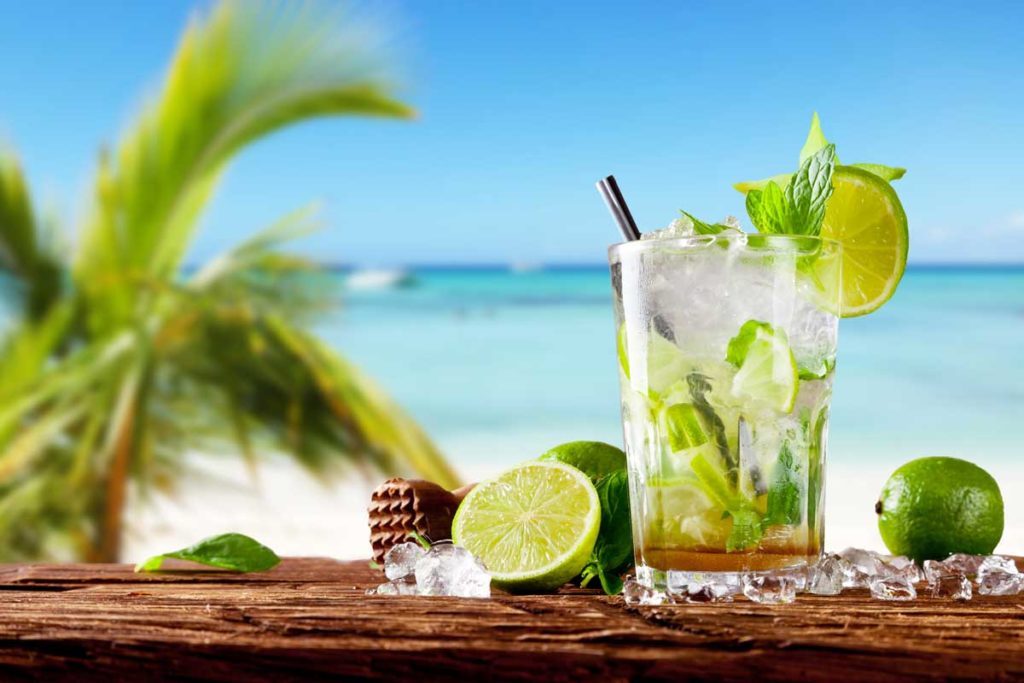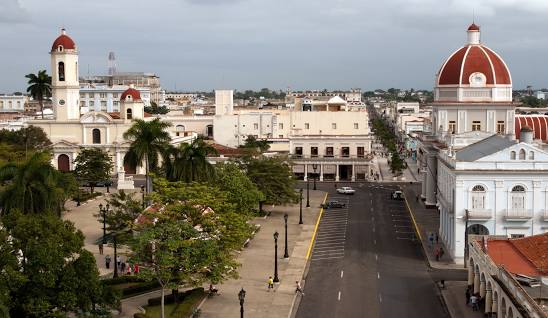BEBIDAS CUBANAS: “EL MOJITO”, SOFISTICADA HERMANA DE LA FAMOSA CUBA LIBRE. FOTOS
El Mojito es un highball cubano tradicional,
El Cóctel Mojito Cubano, otra bebida icónica cubana, es la hermana sofisticada del Cuba Libre. Esta bebida se basa en hojas de menta fresca para capturar el clásico sabor a mojito. Esta es la bebida de verano perfecta para usar menta fresca de tu jardín.
Los ingredientes son aguardiente de caña (traducido como “agua ardiente”, una forma cruda de ron hecho de caña de azúcar) mezclado con ingredientes tropicales locales: lima, jugo de caña de azúcar y menta.
LA FÓRMULA DEL MOJITO
Ron
Servido en las rocas; vertido sobre hielo
Guarnición estándar
ramita de menta (Yerba buena en la receta original)
Vajilla estándar Vaso Collins
Ingredientes especificados por IBA*
4,0 cl de ron blanco
3,0 cl de jugo de lima fresco
3 hojas de menta
2 cucharaditas de azúcar
Agua con gas
Preparación
Ramitas de menta mezcladas con azúcar y jugo de lima. Ron agregado y cubierto con agua de soda. Se adorna con una ramita de hojas de menta. Servido con una pajita.
Tradicionalmente, un Mojito no es muy fuerte (c.10% vol.) y está hecho de cinco ingredientes: ron blanco, azúcar (tradicionalmente jugo de caña de azúcar), jugo de limón, agua con gas y menta. La receta original cubana utiliza hierbabuena o yerba buena, una variedad de menta muy popular en la isla. Su combinación de dulzura, refrescantes sabores cítricos y mentolados pretenden complementar el potente toque del ron y han convertido a este highball claro en una popular bebida veraniega.
Al preparar un Mojito, se agrega jugo de lima al azúcar (o almíbar) y hojas de menta. Luego, la mezcla se tritura suavemente con un triturador. Las hojas de menta solo deben machacarse para liberar los aceites esenciales y no deben triturarse. Luego se agrega el ron y se remueve brevemente la mezcla para disolver el azúcar y levantar las hojas de menta del fondo para una mejor presentación. Finalmente, la bebida se cubre con cubitos de hielo enteros y agua con gas. Se utilizan hojas de menta y rodajas de lima para adornar la copa.
El mojito es uno de los highballs a base de ron más famosos.
ORIGEN
Cuba es la cuna del Mojito, aunque el origen exacto de este clásico cóctel es objeto de debate.
Una historia remonta el Mojito a una bebida similar del siglo 16, el “El Draque”, en honor a Sir Francis Drake. Se hizo inicialmente con tafia/aguardiente, un antecesor primitivo del ron, pero el ron se usó tan pronto como estuvo ampliamente disponible para los británicos (ca. 1650). La menta, la lima y el azúcar también ayudaron a ocultar el sabor áspero de este licor. Si bien esta bebida no se llamaba Mojito en ese momento, todavía era la combinación original de estos ingredientes.
Algunos historiadores sostienen que los esclavos africanos que trabajaban en los campos de caña de azúcar cubanos durante el siglo XIX fueron fundamentales en el origen del cóctel. El guarapo, el jugo de caña de azúcar que se usa a menudo en los mojitos, era una bebida popular entre los esclavos que ayudaron a acuñar el nombre del cóctel. dulce néctar.
Hay varias teorías detrás del origen del nombre Mojito; una de esas teorías sostiene que el nombre se relaciona con el mojo, un condimento cubano hecho de lima y que se usa para dar sabor a los platos. Otra teoría es que el nombre Mojito es simplemente un derivado de mojadito, español para “un poco mojado”, o simplemente el diminutivo de “mojado” (mojado).
El Mojito era una bebida favorita del autor Ernest Hemingway. Ernest Hemingway hizo famoso el bar llamado La Bodeguita del medio al convertirse en uno de sus asiduos y escribió “My mojito in La Bodeguita, My daiquiri in El Floridita“. Esta expresión en inglés todavía se puede leer en la pared del bar hoy , de su puño y letra.
CUBAN DRINKS: “EL MOJITO”, SOPHISTICATED SISTER TO THE THE FAMOUS CUBA LIBRE. PHOTOS
El Mojito is a traditional Cuban highball,
The Mojito Cubano Cocktail, another iconic Cuban drink, is the sophisticated sister to the Cuba Libre. This drink relies on fresh mint leaves to capturing the classic mojito flavor. This is the perfect summer drink to use fresh mint from your garden.
The ingredients are aguardiente de caña (translated as “burning water”, a crude form of rum made from sugar cane) mixed with local tropical ingredients: lime, sugarcane juice, and mint.
EL MOJITO FORMULA
Rum
Served On the rocks; poured over ice
Standard garnish
sprig of mint (Yerba buena in the original recipe)
Standard drinkware Collins glass
IBA specified ingredients*
4.0 cl White rum
3.0 cl Fresh lime juice
3 leaves of Mint
2 teaspoons Sugar
Soda Water
Preparation
Mint sprigs muddled with sugar and lime juice. Rum added and topped with soda water. Garnished with sprig of mint leaves. Served with a straw.
Traditionally, a Mojito is not very strong (c.10% abv) and made of five ingredients: white rum, sugar (traditionally sugar cane juice), lime juice, sparkling water and mint. The original Cuban recipe uses spearmint or yerba buena, a mint variety very popular on the island. Its combination of sweetness, refreshing citrus and mint flavors are intended to complement the potent kick of the rum, and have made this clear highball a popular summer drink.
When preparing a Mojito, lime juice is added to sugar (or syrup) and mint leaves. The mixture is then gently mashed with a muddler. The mint leaves should only be bruised to release the essential oils and should not be shredded. Then rum is added and the mixture is briefly stirred to dissolve the sugar and to lift the mint leaves up from the bottom for better presentation. Finally, the drink is topped with whole ice cubes and sparkling soda water. Mint leaves and lime wedges are used to garnish the glass.
The mojito is one of the most famous rum-based highballs.
ORIGIN
Cuba is the birthplace of the Mojito, although the exact origin of this classic cocktail is the subject of debate.
One story traces the Mojito to a similar 16th century drink, the “El Draque”, in honor of Sir Francis Drake. It was made initially with tafia/aguardiente, a primitive predecessor of rum, but rum was used as soon as it became widely available to the British (ca. 1650). Mint, lime and sugar were also helpful in hiding the harsh taste of this spirit. While this drink was not called a Mojito at this time, it was still the original combination of these ingredients.
Some historians contend that African slaves who worked in the Cuban sugar cane fields during the 19th century were instrumental in the cocktail’s origin.Guarapo, the sugar cane juice often used in Mojitos, was a popular drink amongst the slaves who helped coin the name of the sweet nectar.
There are several theories behind the origin of the name Mojito; one such theory holds that name relates to mojo, a Cuban seasoning made from lime and used to flavour dishes. Another theory is that the name Mojito is simply a derivative of mojadito, Spanish for “a little wet”, or simply the diminutive of “mojado” (wet).
The Mojito was a favorite drink of author Ernest Hemingway. Ernest Hemingway made the bar called La Bodeguita del medio famous as he became one of its regulars and he wrote “My mojito in La Bodeguita, My daiquiri in El Floridita“. This expression in English can still be read on the wall of the bar today, in his handwriting.
Agencies/ Wiki/ CubanMojitoHist./ Extractos/ Excerpts/ Internet Photo/ Barschool/ Arnoldo Varona/ www.TheCubanHistory.com
THE CUBAN HISTORY, HOLLYWOOD.









